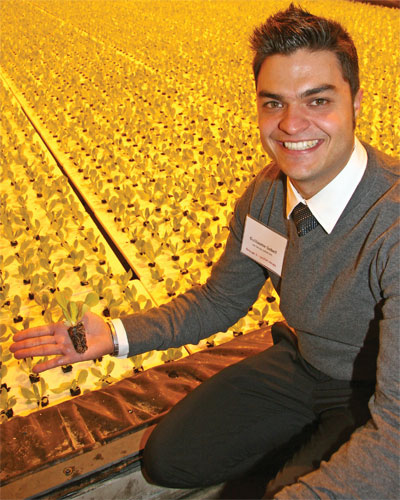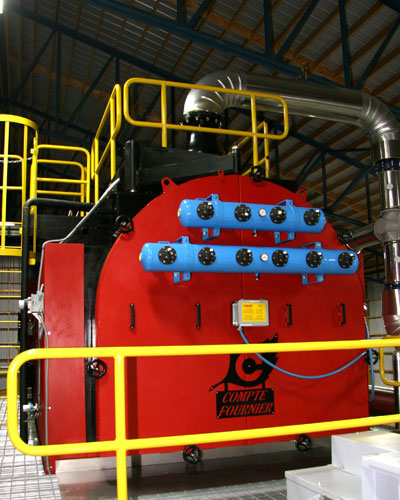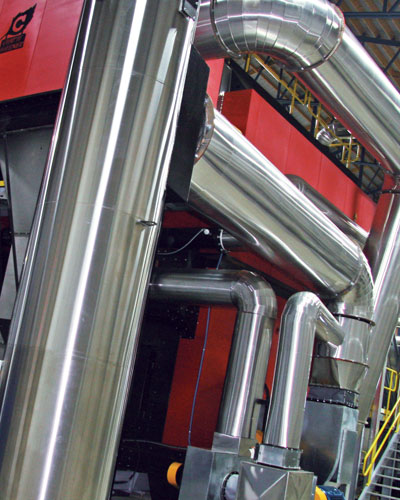
Québec propagator anticipates three-year payback for new biomass system
What do you do when you feel that fossil fuel prices have you over a barrel? If you’re Les Serres Lefort, located in Ste-Clothilde de Châteauguay, on the south shore of Montreal and just 25 kilometres from the New York border, you check for local alternatives.
 |
| Guillaume Gobeil, an engineer and IT manager for Les Serres Lefort. |
Sylvain Lefort and his wife Marie-Josée Lebire run a business specializing in the production of transplants. During its 27 years in operation, this business has won many awards and it is widely respected within the agricultural community.
Les Serres Lefort recently added 1.3 hectares of greenhouses, bringing its total to 6.5 hectares. Included within the latest expansion was the installation of a massive biomass system, an investment of some $7.8 million.
An additional 0.6 hectares will be added this year.
Uncertain about future fossil fuel costs, Les Serres Lefort decided to look beyond propane, the heating system they had used for many years.
“In greenhouse production, energy is one of the major costs,” says Sylvain Lefort. “In 2008, we started to look for alternatives and decided to move forward with forestry biomass.”
 |
| New systems |
Many specialists were involved in the decision-making process, including Jean Gobeil, a forestry engineer and biomass heating systems consultant. Having participated in two other biomass conversion projects, this retired professor from Université Laval is recognized as an expert in this field. “I have visited installations in France, in which a biomass system is used, and I must say that we are just at the beginning. We have a lot to do yet in Quebec in terms of conversion for renewable energy.”
Gobeil completed a feasibility study for the Lefort project. The project received a financial contribution of $5 million from the Bureau de l’efficacité et de l’innovation énergétique from the Québec Ministry of Natural Resources through its program to reduce heavy oil consumption.
“For this project, we had six suppliers on the shortlist, and we chose the technology developed by Compte-Fournier,” he says.
Construction on Lefort’s biomass heating system began in March 2011.
Compte-Fournier is an association of two manufacturers that began in 2010. The partners are GroupeCompte-R, located in France, which has installed over 1,500 medium- to large-size biomass plants throughout the world, and Industries Fournier, situated in Thetford Mines, Québec.
“Our boilers are used in hospitals, district heating networks, industries, greenhouses and even the London 2012 Olympic Games,” says Compte-Fournier president Harold Roy. “We are proud to have installed a system built here in Québec with a technology from Europe.”
TWO 6 MW BOILERS, BUFFER TANKS AND THERMAL CURTAINS
The biomass heating system chosen by Lefort includes two boilers that weigh 100 tons each, an open buffer tank of 1.3 million litres, a hot water system, and energy curtains on the broad-span greenhouses.
 |
| Taking part in official opening ceremonies were, from left to right, Jean Gobeil; Stéphane Billette (a member of the National Assembly of Québec); Sylvain Lefort and Marie-Josée Lebire, owners of Les Serres Lefort; Laurent Lessard (Québec’s Minister of Municipal Affairs, Regions and Land Occupancy); Harold Roy, president of Compte-Fournier; and Dominic Compte, president of GroupCompte-R in France. |
Measuring 80 x 105 feet, the boiler room includes two six-megawatt boilers, which have a thermal power of 12 megawatts (40 million BTU/h). The hot water storage tank (called a hydro-accumulation boiler and made by Starbrite Manufacturing) can store up to 1.3 million litres (345,000 gallons). Stratification is controlled by two diffusers, along with temperature and water level sensors. The unit also includes a corrosion inhibitor.
Some 400,000 litres of hot water circulate within two kilo-metres of greenhouse pipelines.
“This biomass system will contribute to reducing our greenhouse gas emissions by 12,757 tons per year, compared to propane,” says Roy.
“We used up to eight million litres of propane per year,” said Lefort. “We estimate we will save 50 per cent on our energy costs the first year, and get the payback in three years.”
The biomass is supplied by Bois Énergie3G, located in Sherbrooke, and stocked in a new warehouse measuring 890 by 205 feet. “These hemlock residues have a humidity level of 35 per cent, and the system will require five truckloads per day on average, which means 17 to 18 tons annually,” said Gobeil.
According to the manufacturer, the boilers can heat wood residues at a humidity level from 15 to 60 per cent.
“Everything is in the combustion control,” he adds.
PRODUCING GRAFTED PLANTS FOR 250 TRUCK-FARMERS
One of the limited number of businesses that produce grafted plants in Canada, Les Serres Lefort provides transplants of broccoli, cauliflower, tomatoes and celery, among others, for 250 truck-farmer producers, representing nearly 65 per cent of the produce offered in the Québec market.
 |
| This is one of the biggest biomass heating systems in North America. |
Over the last few years, Les Serres Lefort has added a number of new products, including greenhouse vegetable seedlings, square soil blocks, and hydroponic greenhouse lettuces, a move that has led to the production of seven million heads of Boston lettuce each year.
The company operates 12 months a year and has about 50 employees, including an agronomist and a team of technicians. There are also foreign employees during the peak season.
The company has certainly come a long way since Sylvain Lefort, at age 21, started with two greenhouses in his backyard in 1981.
Martine Frigon is a freelance writer/photographer in Québec.
Print this page